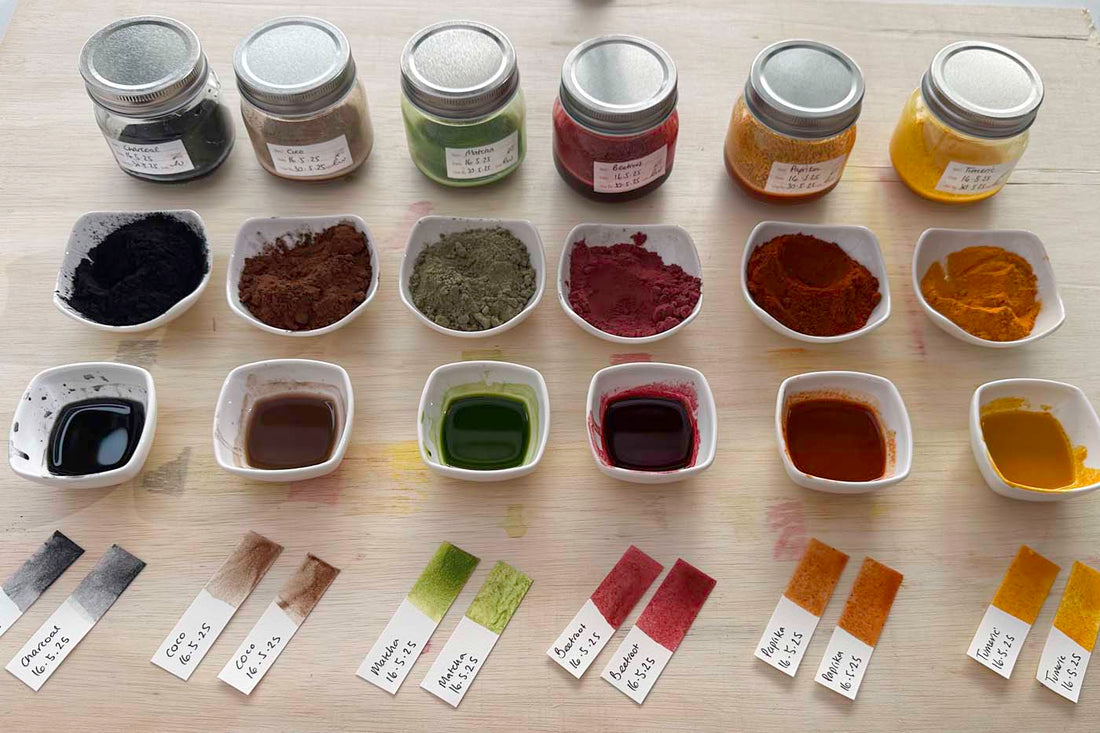
Crafting Pigments from your kitchen cupboard
Share
Natural Paints for Mindful Crafting with Wilde Hippi
In a fast-moving world there’s something deeply grounding about going back to basics. This DIY project from Wilde Hippi is a gentle invitation to reconnect with nature, creativity, and the beautiful simplicity of making something with your hands.
"Crafting pigments from your kitchen cupboard" is ideal for parents, teachers, eco-conscious creatives, and curious kids. It’s safe, sustainable, and full of surprises, a celebration of what’s already around you, just waiting to be transformed.
A Project for All Ages
This activity is perfect for slow afternoons, nature journals, educational projects, or simply exploring the sensory joy of colour. With natural ingredients you likely already have at home, you can mix your own earthy, handmade paints and bring a new layer of intention to your creative time.
The Colours of the Cupboard
In this workshop, we created six natural pigments from common kitchen powders:
- Beetroot powder – Soft berry red
- Paprika – Rusty orange
- Turmeric – Golden yellow
- Matcha – Mossy green
- Cocoa – Warm earthy brown
- Charcoal powder – Deep black-gre

Each pigment has its own personality — some bold and saturated, others gentle and light. While some spread smoothly like a gentle wash, others granulate in beautiful, unexpected ways, leaving behind natural textures that add depth and charm. This tactile quality, so different from store-bought paints, echoes the unpredictability of nature itself. The paint behaves similarly to watercolour, offering a familiar sense of flow but with a grounded, earthy richness that brings every brushstroke to life.
Gather Your Materials
Ingredients:
- Natural pigment powder (beetroot, paprika, turmeric, matcha, cocoa, or charcoal)
- Gum Arabic or Arrowroot powder
- Water (room temperature, filtered if possible)
Utensils & Tools:
- Small mixing bowls or ramekins (one for each colour)
- Teaspoons or small spatulas (for mixing)
- Pipette or small jug (to control water flow)
- Coffee filters (optional for grainy powders like paprika)
- Watercolour paper works best
- Paintbrushes (variety of sizes, soft bristles preferred)
- Jars with lids (to store any leftover paint)
- Paper towels or cloth (for clean-up)
- Labels or masking tape (to date your test swatches)
- Scrap paper for colour testing

Instructions:
In a small bowl, combine 5ml pigment with 5ml of gum Arabic or arrowroot.


Test on paper and adjust thickness as needed for brushwork or washes

Finishing the Artwork
Once dry, you can try layering pens or inks over the paint. I tested a few options and found the Faber-Castell Pitt Artist Pen B worked best. It glides without scratching and adds lovely fine detail without disturbing the pigment.

I also made little “dippers” swatches with the date written on to observe how the paints age over time. Some colours stay vibrant, others like paprika faded quickly. It's a gentle way to watch nature evolve.

See the Process in Action
Watch the full tutorial to see how each pigment is mixed, applied, and tested in real time. You'll also discover simple, creative applications and observe how the paints respond on paper with their unique textures and tones.
Why Make Natural Paints?
This project isn’t just about craft, it’s about values. In a world where art supplies are often synthetic, expensive, and imported, making your own paint becomes a gentle act of resistance and a meaningful step toward conscious creativity. It reduces packaging and chemical exposure, keeps harmful ingredients out of kids’ hands, and reconnects us with ancient, natural ways of making. It slows consumption, nurtures mindfulness, and empowers us to use what we already have turning the everyday into something beautifully intentional.

Creative Ideas for Use:
These natural paints are beautifully versatile, making them ideal for a wide range of thoughtful, creative activities. From kids' art sessions and messy play to eco-friendly party crafts, homeschool lessons, or DIY greeting cards, they bring an earthy, grounding charm to any project. They’re also perfect for mindful practices like nature journaling, meditation through painting, and craft therapy. However you use them, these colours invite you to slow down, be present, and create with intention. “Paint a sun. A leaf. A feeling. These colours are for slowing down.”

Get the Free Recipe Guide
Want to try this at home? download the full recipe card for free.
Order a Paint Set (Singapore Only)
Prefer ready-made? You can now pre-order a batch of handmade Wilde Hippi natural paints, ideal for workshops, gifting, or mindful craft time at home.
